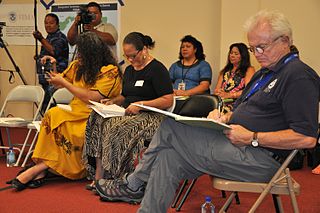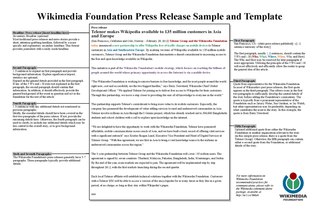
Public relations (PR) is the practice of managing and disseminating information from an individual or an organization to the public in order to influence their perception. Public relations and publicity differ in that PR is controlled internally, whereas publicity is not controlled and contributed by external parties. Public relations may include an organization or individual gaining exposure to their audiences using topics of public interest and news items that do not require direct payment. The exposure is mostly media-based, and this differentiates it from advertising as a form of marketing communications. Public relations aims to create or obtain coverage for clients for free, also known as earned media, rather than paying for marketing or advertising also known as paid media. But in the early 21st century, advertising is also a part of broader PR activities.
Corporate propaganda refers to propagandist claims made by a corporation, for the purpose of manipulating market opinion with regard to that corporation, and its activities.
In marketing, publicity is the public visibility or awareness for any product, service, person or organization. It may also refer to the movement of information from its source to the general public, often via the media. The subjects of publicity include people of public recognition, goods and services, organizations, and works of art or entertainment.

A press release is an official statement delivered to members of the news media for the purpose of providing information, creating an official statement, or making an announcement directed for public release. Press releases are also considered a primary source, meaning they are original informants for information. A press release is traditionally composed of nine structural elements, including a headline, dateline, introduction, body, and other components. Press releases are typically delivered to news media electronically, ready to use, and often subject to "do not use before" time, known as a news embargo.

A press kit, often referred to as a media kit in business environments, is a pre-packaged set of promotional materials that provide information about a person, company, organization or cause and which is distributed to members of the media for promotional use. Press kits are often distributed to announce a release or for a news conference.
Marketing Communications refers to the use of different marketing channels and tools in combination. Marketing communication channels focus on how businesses communicate a message to its desired market, or the market in general. It is also in charge of the internal communications of the organization. Marketing communication tools include advertising, personal selling, direct marketing, sponsorship, communication, public relations, social media, customer journey and promotion.
Reputation management, originally a public relations term, refers to the influencing, controlling, enhancing, or concealing of an individual's or group's reputation. The growth of the internet and social media led to growth of reputation management companies, with search results as a core part of a client's reputation. Online reputation management, sometimes abbreviated as ORM, focuses on the management of product and service search engine results.
A publicist is a person whose job is to generate and manage publicity for a company, a brand, or public figure – especially a celebrity – or for a work such as a book, film, or album. Publicists are public relations specialists who maintain and represent the images of individuals, rather than representing an entire corporation or business. Publicists are also hired by public figures who want to maintain or protect their image. Publicists brand their clients by getting magazine, TV, newspaper, and website coverage. Most top-level publicists work in private practice, handling multiple clients.
Mass communication is the process of imparting and exchanging information through mass media to large population segments. It utilizes various forms of media as technology has made the dissemination of information more efficient. Primary examples of platforms utilized and examined include journalism and advertising. Mass communication, unlike interpersonal communication and organizational communication, focuses on particular resources transmitting information to numerous receivers. The study of mass communication is chiefly concerned with how the content and information that is being mass communicated persuades or affects the behavior, attitude, opinion, or emotion of people receiving the information.

Internal communications (IC) is the function responsible for effective communications among participants within an organization. The scope of the function varies by organization and practitioner, from producing and delivering messages and campaigns on behalf of management, to facilitating two-way dialogue and developing the communication skills of the organization's participants.
Media ethics is the subdivision dealing with the specific ethical principles and standards of media, including broadcast media, film, theatre, the arts, print media and the internet. The field covers many varied and highly controversial topics, ranging from war journalism to Benetton ad campaigns.

An advertising campaign is a series of advertisement messages that share a single idea and theme which make up an integrated marketing communication (IMC). An IMC is a platform in which a group of people can group their ideas, beliefs, and concepts into one large media base. Advertising campaigns utilize diverse media channels over a particular time frame and target identified audiences.
Media transparency, also referred to as transparent media or media opacity, is a concept that explores how and why information subsidies are being produced, distributed and handled by media professionals, including journalists, editors, public relations practitioners, government officials, public affairs specialists, and spokespeople. In short, media transparency reflects the relationship between civilization and journalists, news sources and government. According to a textual analysis of “Information Subsidies and Agenda Building: A Study of Local Radio News”, an information subsidy is defined as “any item provided to the media in order to gain time or space”. In order to understand media transparency, one must gain an understanding of the different aspects in which media transparency is researched, understood, and explored. The following page will attempt to examine media transparency as it has grown and how it affects the modern world.

The Public Relations Society of America (PRSA) is a nonprofit trade association for public relations professionals. It was founded in 1947 by combining the American Council on Public Relations and the National Association of Public Relations Councils. That year, it had its first annual conference and award ceremony. In the 1950s and 1960s, the society created its code of conduct, accreditation program and a student society called the Public Relations Student Society of America.
Earned media is content relating to a person or organization which is published by a third party. It includes articles by media outlets, interviews with the person or representatives of the organization, or bylined editorials in trade press and other publications. It may also include social media sharing and unpaid mentions by podcasters.

Gatekeeping is the process through which information is filtered for dissemination, whether for publication, broadcasting, the Internet, or some other mode of communication. The academic theory of gatekeeping may be found in multiple fields of study, including communication studies, journalism, political science, and sociology. Gatekeeping originally focused on the mass media with its few-to-many dynamic. Currently, the gatekeeping theory also addresses face-to-face communication and the many-to-many dynamic inherent on the Internet. Social psychologist Kurt Lewin first instituted Gatekeeping theory in 1943. Gatekeeping occurs at all levels of the media structure—from a reporter deciding which sources are presented in a headline story to editors choosing which stories are printed or covered. Including, but not limited to, media outlet owner and advertisers.
Corporate communication(s) is a set of activities involved in managing and orchestrating all internal and external communications aimed at creating a favourable point of view among stakeholders on which the company depends. It is the messages issued by a corporate organization, body or institute to its audiences, such as employees, media, channel partners and the general public. Organizations aim to communicate the same message to all its stakeholders, to transmit coherence, credibility and ethics.

CELSA is a French communication and journalism school located in the West of Paris, (Neuilly-sur-Seine) and is part of the Sorbonne University. The name CELSA is an acronym for the French phrase 'Centre d'études littéraires et scientifiques appliquées', i.e. Centre for Applied Literary and Scientific Studies.
A student-run advertising agency acts like a real advertising agency, but is operated by students. The agency can be included in the academic curriculum, allowing students to work in the agency for academic credit. Or, the agency can simply be housed within the academic unit, allowing students to work in the agency for volunteer experience. In other cases, the agency can operate as a student club within the broader organizational structure of the university. The student-run agency provides advertising and similar communications services to various organizations such as college departments, small businesses, and community-based non-profit organizations. Some agencies compete with professionals and charge for services. Other agencies do all their work without charge. Other agencies have a philanthropic focus whereby communications work is conducted for free for nonprofits, while for-profit entities are asked to make a charitable donation to the agency to support its learner-centered focus. Most student-run agencies tend to take an integrated marketing communications focus, combining advertising with public relations and other services.
Public relations is a term that refers to the management of communication between an entity such as an organization or a celebrity, and external actors such as customers or clients. It is concerned with reputation building, and is often considered to be a subset to marketing, advertising, or corporate communication.






